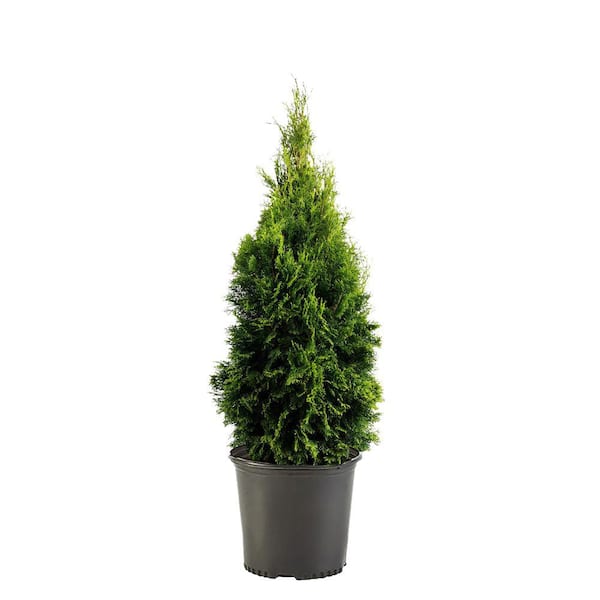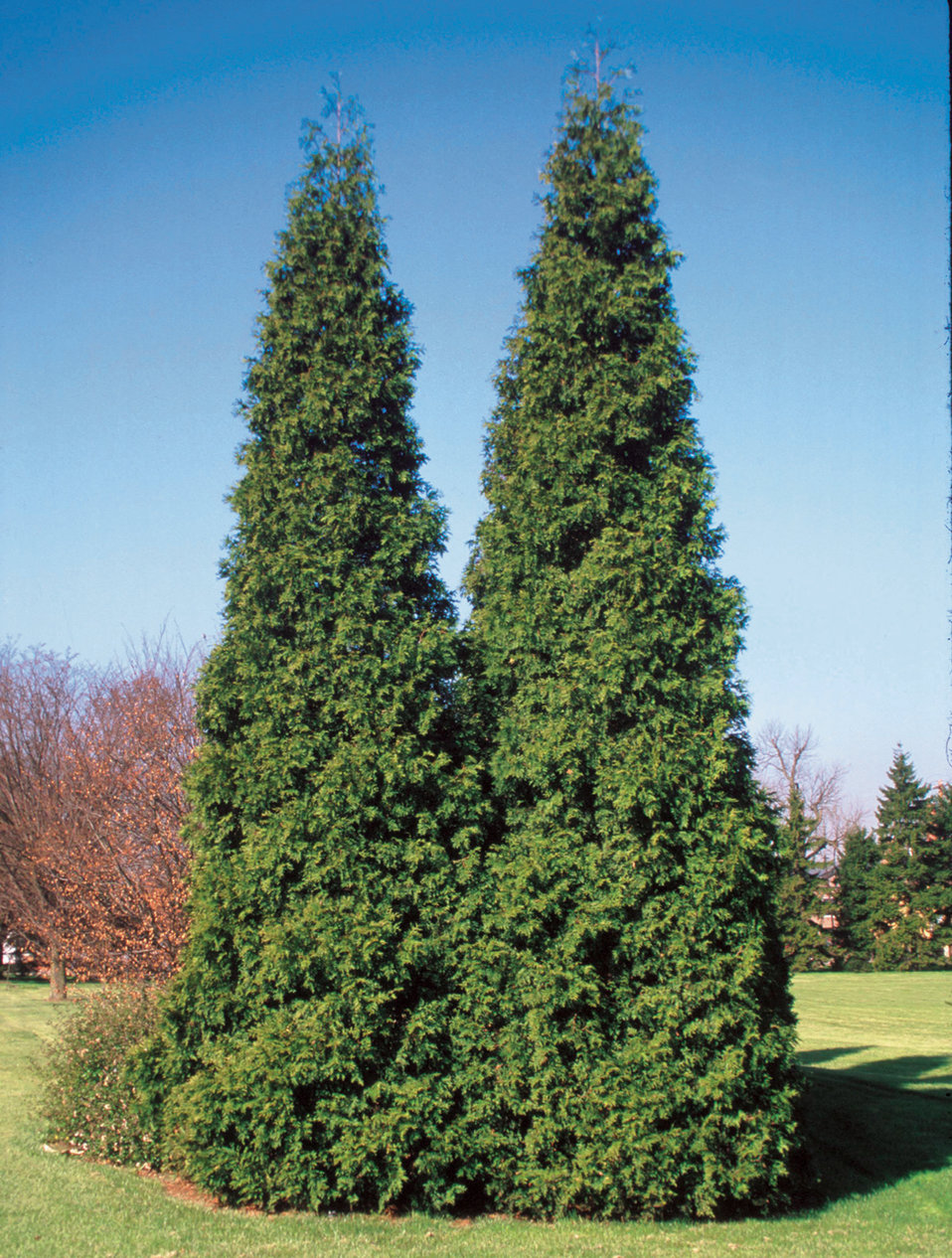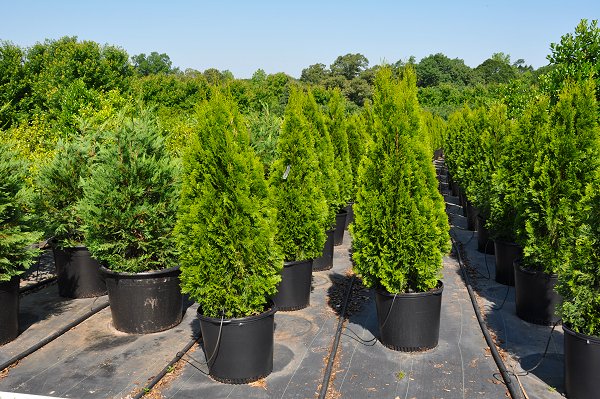Emerald Green Arborvitae Width will be the topic of our conversation on this particular occasion. There is, without a doubt, a great deal of information pertaining to Emerald Green Arborvitae Near Me available on the internet. As a result of the rapid development of social media, it is now much simpler for us to acquire new information.
There is a connection between the pieces of information pertaining to Emerald Green Arborvitae Size, How Fast Do Emerald Green Arborvitae Grow, and Emerald Green Arborvitae Near Me. Regarding the other items that need to be searched, one of those things is concerning What is the optimal spacing for emerald green arborvitae?, which will also have something to do with Emerald Green Arborvitae Watering.

33 Interesting Facts Emerald Green Arborvitae Width | Emerald Green Arborvitae Hedge
- Comments: Tight columnar form is a pleasing shape and look, and this tree holds its beautiful deep green color very well. No pruning necessary, except to level the top of the row of trees if desired. For more information see: “Everything You Need To Know About Arborvitae” . Thinking of buying small arborvitae? You need to read the “Hedgerow Hedge Woe” article that describes why you don’t want to start with small trees. - Source: Internet
- The following arborvitae types are the most commonly planted. Information is included for each type, detailing what traits makes them unique, their mature size, and preferred growing conditions. As you will see below, they can also be referred to as different types of Thujas, which is their scientific name. - Source: Internet
- If you do want to change the shape of your Emerald Green arborvitae, it may be helpful to set a goal before pulling out the shears. If you want to shorten a tall hedge, you may want to do so in the spring: the plant can maintain itself throughout the summer. If you’re planning to majorly shorten your hedgerow, cut it in late winter, before nutrients start to travel up the leaves and branches. If you want to prune your hedges in order to maintain an ornamental look, prune in the late summer before cool weather sets in. That way, your arborvitae tree will have time to grow a few shoots before the winter, and its edges will harden off before the frost. - Source: Internet
- Like the Firechief, the Dwarf Golden arborvitae grows in a compact, rounded habit. Reaching a maximum of 6-feet tall, this variety works great as a border plant or grown in containers. During the active growing season, the foliage is bright, golden yellow; it deepens to a rich bronze in winter. - Source: Internet
- I want to plant a privacy hedge with emerald green arborvitae. I am trying to determine the most economical trunk-to-trunk spacing that will eventually result in a hedge you cannot see through at eye level. I know that emerald green arborvitae have a mature width of 3 to 4 feet, but I’ve read conflicting advice on how far apart to plant them: anything from 2 to 4 feet trunk-to-trunk. These trees are expensive, so I want to purchase as few of them as possible. - Source: Internet
- Developed in Denmark, the Emerald Green arborvitae, or Emerald Green Thuja, is named (and known) for its striking green foliage — “Smaragd” is the danish word for emerald. Considered a semi-dwarf variety, it grows in a narrow pyramidal shape to about twelve feet in height when fully mature. It is an extremely thick, dense evergreen making it an excellent hedge. This variety holds its vibrant color and form throughout the changing seasons. - Source: Internet
- Add a layer of the fertile soil you had put separately. Use a shovel to spread it in the hole as you flatten it. It is best if you make the hole’s width double the width of the pot you had bought your Arborvitae in. Doing so gives the tree more room for growth. The roots also get softer soil to draw nutrients from before they are mature enough to penetrate through the harder soil layers. - Source: Internet
- When you prune an arborvitae, be sure not to prune the limbs all the way to the branch — bare limbs are unlikely to become green again. Instead, keep your cuts within green wood, so that the plant will be able to fill itself back in. Cut overgrown edges slightly behind the “sight line” — the desired edge to your plant’s bushiness. And, be sure to keep the base of the arborvitae wider than the top. Not only will a conical shape help you avoid the dreaded “hot dog” look, conifers grow conically for a reason: the pyramidal shape allows the sun to reach all levels of the tree. - Source: Internet
- One of the most compact varieties, Golden Globe arborvitae naturally grows into a compressed globe shape. These small scrubs maintain bright golden yellow foliage year-round. Their small stature predisposes them for use as short hedges, foundations plants, border plants, or container-grown specimens. - Source: Internet
- In the fall, arborvitae and other conifers shed their oldest (innermost) needles. These needles turn yellow or brown and drop to the ground in late fall – winter. So, each spring I shake out my trees and get all of the dead needles out of the branches (sometimes they get stuck). It takes me about an hour each spring. - Source: Internet
- ‘Emerald Green’ arborvitae usually reaches just 12-14 feet tall, with a spread of 3-4 feet. It grows in a pyramidal form. Its foliage comes in flat sprays and, if you look closely, the needles appear covered in scales. It is not the fastest grower in its group (that would be the ‘Green Giant’ cultivar), but the trade-off is that the size of this slow grower is often just about right for a privacy hedge. - Source: Internet
- ‘Emerald Green’ arborvitae is an evergreen in the Cypress family (Cupressaceae). A slim tree of medium height, these arborvitae can reach 14-15′ high and 3-4′ wide. They can be grown in zones 2-7 and make a great privacy hedge. - Source: Internet
- The slow growth rate of these gorgeous privacy trees can actually be a benefit: they won’t become leggy or “furry” in appearance." Emerald Green is a semi-dwarf arborvitae variety, so it won’t develop that shaggy, unkept “insta hedge” look that other arborvitae varieties sometimes have. These beautiful conifers aren’t instant hedges, but their look is well worth the wait. - Source: Internet
- These arborvitae hedges don’t tend to grow particularly wide, and maintain their narrow shape with minimal pruning. You can expect a spread of 36 to 48 inches on your Emerald Green arborvitae, and you can plant them relatively close together. We recommend spacing them of 24 to 36 inches apart. - Source: Internet
- Native to America, the American arborvitae was the first North American tree to be introduced into Europe. It is known for its long life expectancy; some specimens are dated at more than 1000 years old. Growing in the standard narrow, conical arborvitae shape, trees may reach upwards of sixty feet tall to make them popular as windbreaks. - Source: Internet
- If you want to make your arborvitae grow better, you should put some fertilizer on your plant. Then, you should water your plant and make sure that the sun doesn’t dry out the plant. The soil should be moist, and you should use a fertilizer that contains nitrogen. - Source: Internet
- However, you do need to consider drainage when you decide where to locate your arborvitae. These hedges don’t like soggy feet, and their roots can rot when too much water is combined with poor drainage. Don’t plant them in low, wet parts of the yard, and make sure that downspouts and drainage ditches don’t empty onto your arborvitae. - Source: Internet
- The “how far apart to plant arborvitae green giant” is a question that has been asked many times. Arborvitae is a type of evergreen shrub with dark green foliage and white flowers. The distance between plants will vary depending on the species, but typically they can be planted 1 foot apart for every 16 inches in height. - Source: Internet
- Generally, arborvitaes are dense, easy to care for, hardy evergreen shrubs or trees. Their iconic greenery makes them a staple in American landscape designs to create hedges and privacy screens, or conceal foundations and other eyesores. They thrive in almost all climatic regions across the United States and the different varieties grow to varying sizes while displaying interesting traits. - Source: Internet
- You can also fertilize your Emerald Green arborvitae. I am a big fan of Espoma products so I’ve always used Plant Tone (buy on Amazon) to fertilize my arborvitae. This is a 5-3-3 fertilizer, which is 5 parts nitrogen, 3 parts phosphorus and 3 parts potassium. Just follow the instructions on the back of the bag to use it. I fertilize my arborvitae in the spring and sometimes in the fall. - Source: Internet
- The Emerald Green arborvitae has a moderate, slow growth rate of about 1feet in a year. After planting, they take around 3 to 4 years to establish, and then they begin to grow at a fast rate. The upside of slow growth rate is they tend to have a longer lifespan than those with a rapid growth rate. Fast-growing trees are prone to diseases. - Source: Internet
- Shimmering emerald green foliage with a classic narrow, pyramidal form make the emerald arborvitae attractive in all seasons. And unlike other arborvitaes, this cultivar keeps its lustrous color even in the cold winter months. The emerald arborvitae is great for specimen or accent planting, hedges, privacy screens and shelterbelts. It also makes a good foundation plant. - Source: Internet
- This semi-dwarf Thuja hedge, unlike some coniferous hedges, isn’t a particularly fast grower. Emerald Green arborvitae can grow up to one foot per year, landing at an impressive height of 10 to 15 feet. However, these hedge plants are easy to maintain by pruning: a yearly trim will keep them at their desired height and shape. - Source: Internet
- My arborvitae are spaced at 36″ apart. I’ve included some photo examples so you can see the difference in spacing as the hedge grows. These are rows of Emerald Greens from all over my neighborhood. - Source: Internet
- I chose Emerald Green arborvitaes for my privacy tree. It’s recommended to plant them 3′-4′ apart to form a privacy hedge when full grown. I chose to plant them 3′ apart from trunk to trunk. You can also ask the nursery how far apart to plant your new trees. Determine how far you’ll space them from your fence or property line. - Source: Internet
- From their beautiful pyramid shape that can create a breathtaking look to being versatile, Emerald green arborvitae plants are loved by many. They are used for different purposes, i.e., as decorations, living fences, and windbreakers. - Source: Internet
- Another advantage to this arborvitae cultivar? It won’t overwhelm your landscape with too much horizontal growth. Emerald Green will grow to a maximum width of 3’ to 4’ wide, with minimal pruning. Arborvitae are beloved for their ability to naturally maintain an aesthetically-pleasing, neat, and conical shape. But, these plants are also amenable to pruning, as long as you plan ahead. - Source: Internet
- If you’re worried about nearby foundations or septic systems, you’re in luck: the Emerald Green arborvitae does not have particularly invasive roots. Just as Emerald Green arborvitae plants don’t spread out above ground, they stay relatively compact below the surface. You won’t be calling for sewer service due to these plants! - Source: Internet
- Just for fun, here’s a photo of my emerald green arborvitae trees after a snowfall here in Northeast PA. This is about 4 years after planting and they’ve grown about 2 feet. I love how they catch the snow on their branches! - Source: Internet
- Mulching is one of the best things you can do when you plant privacy trees. This really helps your trees retain the water your give them – so they don’t dry out. Use about a 3″ layer of mulch around your arborvitae. - Source: Internet
- Plant your arborvitae privacy trees so that the root ball is level with the ground surface; maybe a tiny bit above, but never below. By measuring the height of the root ball you know how deep to dig your hole. Most of my 4′ ‘Emerald Green’ Arborvitae had root balls that were between 11″ and 13″ deep. - Source: Internet
- The Firechief arborvitae stands out because of its more compact shape and distinctive color shifts throughout the year. Instead of standing upright in the traditional pyramid form, shrubs are much smaller and globe-shaped. Foliage on the Firechief is bright gold in the spring, deepening to orange in the summer and bright red in the autumn. It never drops its leaves/needles as an evergreen, but they return to their brilliant gold color as winter fades. - Source: Internet
- This evergreen tree grows to mature height of 15’ with a width of 4’-5’. Each year it puts on 6”-9" of new growth once established. The foliage is soft, bright green and arranged in somewhat vertical fanlike sprays. Upon close examination the small, scale-like leaves overlap forming flattened, rope-like shoots. - Source: Internet
 To get you started, here are some pointers to consider when searching for information regarding Hedging Cedars:
- Do some research to find Emerald Green Arborvitae Staggered Spacing-related information from reputable sources. This may include professional journalists, as well as online libraries and other websites.
- When looking for information regarding Find your growing zone, it is crucial to be aware of the various types of sources that can be found through electronic media. Some examples of these types of sites include Google and YouTube. There is also the possibility of obtaining information about Emerald Green Arborvitae Care from various social media sites, such as Facebook and Twitter. This is another another potential source.
To get you started, here are some pointers to consider when searching for information regarding Hedging Cedars:
- Do some research to find Emerald Green Arborvitae Staggered Spacing-related information from reputable sources. This may include professional journalists, as well as online libraries and other websites.
- When looking for information regarding Find your growing zone, it is crucial to be aware of the various types of sources that can be found through electronic media. Some examples of these types of sites include Google and YouTube. There is also the possibility of obtaining information about Emerald Green Arborvitae Care from various social media sites, such as Facebook and Twitter. This is another another potential source.Video | Emerald Green Arborvitae Width
Reading and doing research on the authenticity of each source are both essential if you want to discover the greatest information there is about Emerald Green Arborvitae Spacing From Fence. Your understanding of Green Giant Arborvitae Spacing will be improved by watching the many videos on Emerald Green Arborvitae Hedge Bundle that are included in this page. These films come from a variety of different sources. Finding knowledge on a wide range of subjects is made much simpler by making use of the internet as a resource.
## Here are some crucial points concerning emerald green arborvitae spacing for privacy:- Emerald Green Arborvitae Width
- Emerald Green Arborvitae Spacing
- Emerald Green Arborvitae Hedge
- Emerald Green Arborvitae Spacing Calculator
- Emerald Green Arborvitae Spacing From Fence

You won’t have any trouble finding the information you’re looking for because there are so many websites and forums on the subject of emerald green arborvitae width.
When it comes to obtaining information on Green Giant Arborvitae Spacing, the majority of individuals are more accustomed to using a different route. It enables a more in-depth look at the information regarding Emerald Green Arborvitae Growth Rate’s content and how it may be used, which is really helpful.

strategies to design information displays that are both aesthetically pleasing and functional that pertain to Emerald Green Arborvitae Spacing From House. They are useful in commercial and marketing settings, and they can also be put to use to convey information on emerald green arborvitae spacing from house. As a result, we also supply some photos pertaining to Hedging Cedars.
In summary, this article offers a comprehensive analysis of emerald green arborvitae spacing from fence. In addition, Emerald Green Arborvitae Hedge and Emerald Green Arborvitae Width are mentioned here as a comparison of your knowledge regarding emerald green arborvitae spacing calculator.